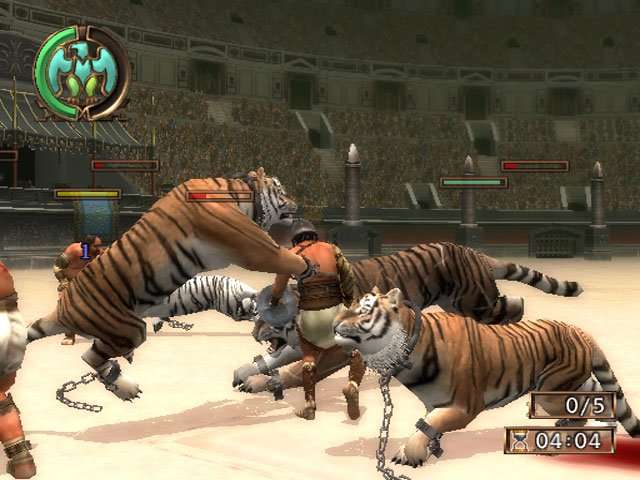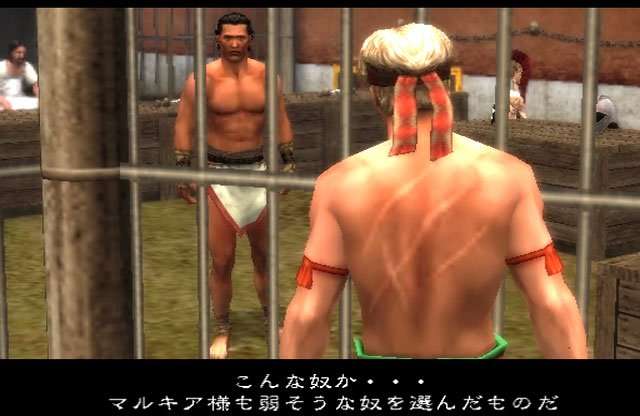Colosseum: Road to Freedom
Colosseum: Road to Boredom, more like.
You want to know about Colosseum, yes? Well, you’ll have to make your way through this paragraph first.
Now you’re in a second paragraph. Have a look around here for some information of some sort, or anything of interest, but there’s nothing. Just carry on reading these words for a bit, and then you can find the third paragraph.
Here’s the third paragraph. Nothing much happening here either. A little bit depressing. Just carry on a little more and maybe they’ll be something you can get your teeth into. Surely Eurogamer wouldn’t waste four entire pargraphs on some kind of concept piece?
Fourth Paragraph and they clearly would.
And fifth too. Where the hell is the bloody review? It’s got to be around here somewhere. It says review at the top of the page. They wouldn’t lie in such a profound and glaring way. Maybe there’s some kind of error and they’ve printed a load of rubbish instead of the review? And not for the first time. Why are there so many useless paragraphs here? You don’t understand what’s going on.

Colosseum: Road to Freedom is a beat-‘em-up with role-playing character development elements, starring you as a Gladiator trying to accumulate enough cash to buy their freedom. Phew. At last.
While Colosseum is a possessor of an array of faults to have a nice little natter about for the remains of the review, it’s the passing, strange ones which stick. Put aside the camera controls, or the character responsiveness or the general repetitiveness; why do the designers think it’ll be a good idea to walk through a good half-dozen completely empty screens on the way to fight in the colosseum?
It’s as if the designers were napping through most of the design lecture talking about atmosphere, waking up for the bits talking about how actually creating a framing environment to move through can make everything seem part of a real world. However, they missed the bits where these environments had to be full of visual splendour and characters to interact with to create the illusion, and instead just lobbed together some empty boxes of pseudo-roman architecture with some semi-naked Chippendale types walking around in formation.
(Every time you go to one of the arenas, three fellow gladiators walk out of the truck after you, slowly, within a few inches of each other. In perfect time. In their loincloths. You’re half expecting for them to announce “Hello, ladies… your entertainment is here”.)
While the route into the Colosseum itself is worse, there are similar extraneous rooms outside the smaller arenas, between your barracks and the training field and even a mess hall. Add small loading pauses between most of them and a seemingly random mixture of skippable and unskippable cut-scenes pre-bout and you’ve got something which just goes out of the way to alienate you. Even worse, it disguises the game’s options. By positioning the equipment shop in an area you’d never normally go, it managed to conceal its existence for most of my playing time before I accidentally stumbled into it.
What’s wrong with a nice menu, eh? It’s not as if your graphics engine is anything you’d want to show off.

It’s also worth noting that obfuscation is a general theme – there’s a two player mode, but you only discover it by selecting one of the game’s three arenas in the single-battle modes. Select any of the other arenas, and it’s not there. When you start the single player game, you’re asked questions about what your background is to determine your starting stats, but none of the options include the slightest hint what they actually mean. Do I want to choose the route of Survival or Destiny? Who can tell? When in the practice yard, which of the exercises improve which of the abilities? In terms of explaining things to a new player, the designers believe firmly in a less is more policy. Or, more probably, less is less effort.
The game follows a simple sequence. You alternate between a day of training and a day at the circus. However, it’s a Roman-style circus, which means that rather than performing prat-falls in a clown suit to amuse children you kill dozens of your fellow men to amuse children.
On your training day, you perform two exercises, with simple mini-games – rhythm-action sequences, target galleries, etc – that your level of success determined the amount of points you have to distribute across your statistics. Be the strong but slow character, the fast but weak character or the (always unfortunate) weak but slow character? It’s for you to decide.
On the day at the arena, you get to choose which events you wish to enter – from multi-way brawls, to single-foe duels, to battles against beasts, to recreation of historical battles. Win, and ninety percent of your cash goes towards the game’s objective of paying off your huge debts and making you a free man, leaving ten-percent to be used to pay for resurrections when you die. Mainly, anyway. There’s that shop, if you can find it, and even slaves to gather when you manage to become a high-rank gladiator.
Its basic structure of slow improvements followed by bouts to play with your new talent is what gives Colosseum its basic structure and simple compulsiveness. Even if the bouts aren’t much fun and the RPG-elements are relatively straight-forward, the inching towards greater powers with new special moves gives it a sense of direction.
This is Colosseum’s Good Point.
Rather than God of War’s and the forthcoming Spartan’s beyond-macho fantasies of ultimate-manhood, Colosseum takes a more grounded approach. Yes, you may have to defeat thirty people in an arena before winning a round, but you’d only be taking three on at a time, max. It’s important to pay attention to armour, blocking and dodging, with a button-bashing approach normally ending with your fighter exhausted and bisected by someone’s gladius. There are also three main styles, centring around sword and small shield, weapon and large shield and two one-handed weapons, each with their own advantages and special moves.

All of this would have been a welcome change, except the control system kind of fumbles it, especially when married to one of the least able camera seen this year. There’s extremely little assistance in terms of choosing a target for your blade – and when the game is resting upon you to make swift, perfectly aimed counter-attacks, this muddiness makes everything a little too random. It’s particularly bad with parrying – time right, and you block. Don’t time right and you make a normal attack, ruining the guard. Linking special attacks by pressing one of the left triggers, combined with a normal button is a reasonable idea, but less appealing when the other left trigger and the button just makes you lob your weapons across the arena.
But it’s the camera which makes the desired precision too elusive. It’s entirely under the player’s control, requiring constant manual orientation to see what’s going on, which is exactly the sort of thing you don’t have time for when trying to avoid three are-you-Gladiator?-yes-she-was-very-tasty tigers on the sandy floor of the Circus Maximus. It’s most laughable in the smaller arena, where large spiked pillars rise from the ground. They’re meant to be deadly by you pushing your foes onto them to be hurt, but in actual play they provoke more injuries by just blocking your view to the action. Bloody architects.
While the simple structure makes it compulsive, it also leaves it unsophisticated. While there’s a few variants, most fights take place in the same few arenas and feature the same objectives, i.e. kill everyone with your sword in a crowd-pleasing manner. That your financial rewards are linked to how much you show off – length of combos, number of dodges – is the closest that Colosseum gets to another Good Point.
Minor annoyances grow larger the more you have to face them. Forget the slow presentation – though that they’ve put options in multiple places in an area rather than in a menu makes it worryingly easy to step into a bout with something important missing from your set up (Like having a set of shield-based special powers equipped when you’re using dual blades). For example, the best way to get more equipment is to take it from the bodies of the dead. This means that you have to drop whatever you’re carrying to pick any extra item up on the way out. However, after the bout is won, you’re transported to the middle of the arena to bow, so you have to rush back to wherever you were to salvage the equipment before the timer drags you out. It’s all clumpen and lumpen and no-fun-en.
But, returning to the original strange wandering into the arenas, you know what the worst thing is? When you’ve completed all the days' events, when there’s nothing else to be done, you’d think you’d just be brought back home automatically. Except not. You know what actually happens?
Well, an empty paragraph.
And another one.
And a third.
Are we there yet?
Almost.
You have to walk all the way out to get back on your truck. I mean… why?
Though, if you’re considering Colosseum: Road To Freedom, that’s a question you should get used to asking.

